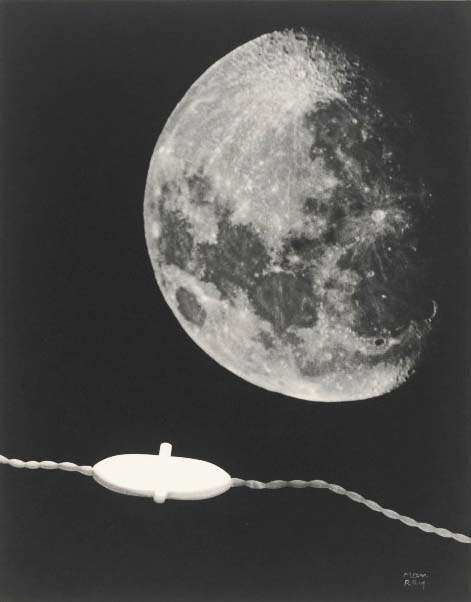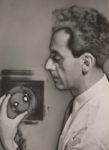
Man Ray
American, 1890–1976 (active France)
Le Monde, 1931
photogravure
10 1/4 × 8 in.
SBMA, Museum purchase with funds provided by PhotoFutures
2010.32

Man Ray, 1931, solarized self-portrait.
"I do not photograph nature. I photograph my visions."
"Of course, there will always be those who look only at technique, who ask "how", while others of a more curious nature will ask "why". Personally, I have always preferred inspiration to information."
- Man Ray
COMMENTS
Man Ray had experimented with electricity in photographic processes as early as 1917 and throughout the 1920s, inventing two types of photographs: rayographs and solarized images. Invented by chance in 1917, rayographs were produced by placing various objects on light sensitive paper in the darkroom and exposing the paper to light, creating images that resemble x-rays, as in the light switch in Le Monde. Solarized images were made by briefly exposing the developing negatives to light, which creates a halo effect around the object depicted. The images in the Electricité portfolio suggest both domestic and commercial uses of electricity, anticipating its worldwide significance.
- The Heckscher Museum of Art, Huntington, New York, 2007
http://www.heckscher.org/pages.php?which_page=collection_image_detail&which_image=2007_002_005
Born Emmanuel Radnitsky, the American artist Man Ray came to prominence within the context of the Dada and Surrealism movements, first in New York then in Paris, between the two world wars. Although he strove for recognition as a painter, it was with his photographs—and in particular with his mastery of experimental techniques such as the photogram, solarization, and multiple exposures—that he made a lasting name for himself as one of the most innovative artists associated with Modernism. Whether portraying artist colleagues, reinventing the classical genre of the nude, or assembling still lifes from commonplace objects, his photographs are often infused with the enigmatic qualities and strange juxtapositions that are the hallmarks of Dada and Surrealism.
Le Monde is one of ten images that Man Ray created in 1931 for Électricité, a portfolio commissioned by one of several private electric companies competing for customers in France. Other images depict house- hold appliances—a toaster, an iron, and a fan—as well as a single light bulb and the pulsing lights of the city. Produced as photogravures and issued in an edition of 500, the images were intended to promote the consumption of electricity in domestic settings. Electricity was still a novel form of energy, accessible primarily to industry and the wealthy; the onset of the Depression encouraged La Compagnie Parisienne de Distribution d’Électricité to target middle- class consumers. Man Ray was the perfect candidate for such a commission; not only did he live in one of the first electrified buildings in the district of Montparnasse, but electric light was essential for his livelihood.
Le Monde exemplifies the innovative, playful spirit with which Man Ray approached both personal and commercial projects. While printing a negative of the moon using the electric light of his enlarger, he laid an electrical cord across the lower half of the sheet of photographic paper, combining the actual size of the photogrammed on-off switch with the distant orb, as if to suggest that the light of the moon could be so easily controlled.
- Virginia Heckert, Curator and Departmental Head, Photographs, J. Paul Getty Museum, Los Angeles, in 25 in 75 Important Acquisitions at SBMA, 1990-2015, 2016
